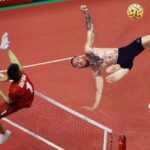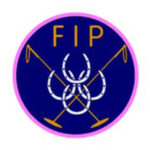About Hanetsuki
Hanetsuki is a traditional Japanese form of Badminton, which is usually played as part of New Year’s Festivities in Japan (January 1 in the Modern Calendar) [2]. Along with a traditional card game, Kite Flying, a Battle of the Bands between two of Japan’s most popular musical artists [2] , and the Rice Bowl – Japan’s American Football Super Bowl – it is one of the Games highlights of celebrating New Year in Japan.
The game is similar to the old European game of “Battledore and Shuttlecock”, which is no doubt derived from similar games in East and South East Asia which gave rise to the modern sport of Badminton [5] . Hanetsuki is played by usually by two girls with a wooden paddle and a shuttlecock but with no net and the object of the game is to keep the shuttlecock in the air as long as possible by batting it to each other [2, 3]. The girl who lets the shuttlecock drop gets marked with India Ink [2], or in another tradition, has to pay for the Kimono [3]. It is traditionally played in a Kimono [3].
Although the sport or game is not as popular as it once was highly decorated paddles, called Hagoita, are sold throughout Japan as ornaments [2, 3]. Hanetsuki is first mentioned in the Nara Period (710-794 AD), when the Imperial Capital was in the Japanese City of the same name. This is the period when the Nihon shoki – the origin myth of Japan – was written [3].
Hanetsuki Paddle (Hagoita)

Item ID: 1195451194
Photographic Contributor

References
[1] Tradition & Games WordPress Blog (2015) Hanetsuki [Internet] Available from: https://traditiongames.wordpress.com/2015/08/03/hanetsuki/ [Accessed 20 December 2021
[2] Nipponario (2013) Hanetsuki Badminton [Internet] Available from: http://nipponario.abranera.com/?p=2665#sthash.bEXccKDI.dpbs [Accessed 20 December 2021]
[3] Nipponary (2012) Nara Period [Internet] Available from: http://nipponario.abranera.com/?p=81#sthash.jjgK4stD.dpbs [Accessed 20 December 2012]
[4] Japan Centre (2021) Celebrating Shogatsu – New Year in Japan [Internet] Available from: https://blog.japancentre.com/2021/12/20/celebrating-shogatsu-new-year-in-japan/ [Accessed 20 December 2021]
[5] National Badminton Museum (2021) The Game of Battledore and Shuttlecock [Internet] Available from: https://www.nationalbadmintonmuseum.com/battledore-and-shuttlecock/ [Accessed 20 December 2021]
Image References
[6] Shutterstock (2021) Hagoita [Internet] Available from: https://www.shutterstock.com/image-photo/good-luck-charm-japanese-hagoita-1195451194 [Accessed 20 December 2021]
ACKNOWLEDGEMENTS
Thanks to Caoilfhionn Nic Fhearai
ABOUT THIS DOCUMENT
Researched, compiled and written by Enda Mulcahy for the
Eirball | Irish North American and World Sports Archive
Last Updated: 20 December 2021
(c) Copyright Enda Mulcahy and Eirball 2021
You may quote this document in part provided that proper acknowledgement is given to the authors. All Rights Reserved. The Logos and Photos used in this article remain the property of the organisations and individuals which own the copyright and are used here for educational and information purposes only.










